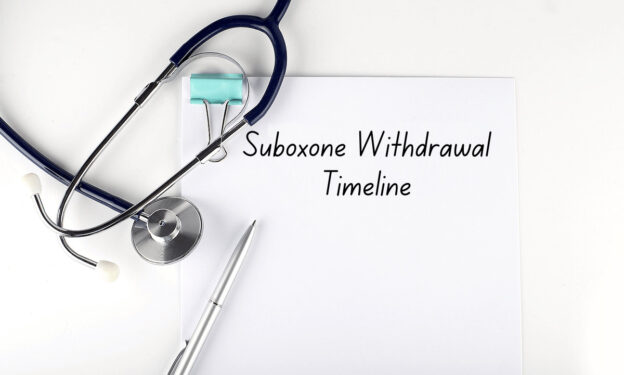Introduction: Understanding Suboxone and its Role in Opioid Treatment
Suboxone, primarily used to treat opioid addiction, is a blend of buprenorphine and naloxone. These components serve a dual purpose: buprenorphine alleviates withdrawal symptoms, while naloxone prevents potential misuse. Ironically, while Suboxone plays a crucial role in addiction treatment, it can become a source of dependence due to its opioid component, making the cessation process challenging.
Delving Deeper into Suboxone Withdrawal Symptoms
Suboxone withdrawal symptoms are a complex blend of physical and psychological manifestations. This spectrum ranges from mild discomfort to debilitating conditions.
Common Symptoms to Expect:
- Digestive issues: stomach pain, diarrhea, nausea, and vomiting.
- Sleep disturbances: Insomnia and restless nights.
- Physical debilities: bone aches, muscle cramping, and general weakness.
- Temperature fluctuations: hot or cold flashes.
For over 25 years, people from all over the world have chosen Waismann Method as their opioid detox provider.
We know the challenges you face and the importance of creating a unique and personal experience for you right from the start.Call for Detox Options 1-800-423-2482
Severe Symptoms Include:
- Respiratory complications.
- Lightheadedness or fainting spells.
- Persistent fever and cough.
- Urinary complications: pain or difficulty during urination.
It’s paramount to seek medical guidance if severe symptoms emerge.
The Suboxone Withdrawal Timeline: A Comprehensive Step-by-Step Guide
Suboxone withdrawal can be complex, with both physical and psychological symptoms experienced by the individual. Here’s a detailed breakdown of the typical withdrawal timeline:
Week 1: The Onset Phase
- Days 1-3: As the body starts to crave the medication, initial symptoms manifest rapidly. These can include acute anxiety, muscle aches, excessive sweating, and restlessness. Sleep becomes elusive, often marked by frequent awakenings and vivid dreams.
- Days 4-7: Towards the end of the first week, while some symptoms such as mood swings and body aches begin to stabilize, new issues, like nausea or abdominal pain, might arise. The individual may also experience teary eyes, runny nose, or dilated pupils, mimicking flu-like symptoms.
Week 2: The Transition Phase
- Days 8-10: The second week witnesses a decline in severe physical symptoms, giving way to a more pronounced emotional and psychological challenge. Symptoms like yawning, mild disorientation, and temperature dysregulation might occur sporadically.
- Days 11-14: Depression becomes more noticeable, compounded by ongoing insomnia and fatigue. Some may experience irritability or episodes of rapid mood changes.
Week 3: The Psychological Battle
- Days 15-21: This week can be particularly trying. The body may have adapted to the absence of the drug physically, but the psychological grip remains. Drug cravings can intensify, with intrusive thoughts about using. Depression persists, and anxiety can flare up, especially in socially triggering situations.
Post 1st Month: The Lingering Phase
- Days 22-60: By now, the majority of physical symptoms have ebbed. However, the mind may still be grappling with the absence of the drug. Emotional flatness, sporadic anxiety episodes, and unpredictable mood swings can continue. During this time, it’s not uncommon to experience moments of mental clarity, followed by periods of fog or confusion.
- Months 2 and beyond: The prolonged fight is majorly psychological. While acute cravings might reduce, they can still emerge, especially during stressful periods or when encountering triggers. Ongoing therapies, support groups, and medications like Naltrexone or Vivitrol can be invaluable in bolstering the individual’s resilience against relapse.
The journey through Suboxone withdrawal is unique to each individual, depending on various factors like the duration of use, the dosage, co-existing health conditions, and personal resilience. It’s crucial to approach this period with professional guidance and a robust support system to navigate the challenges and ensure a sustainable recovery.
How Long Does Suboxone Stay in Your System?
Suboxone, primarily known for its ingredients buprenorphine and naloxone, stands out as a cornerstone in the medical treatment of opioid dependency. Understanding its duration in the system is crucial, not just for medical practitioners, but also for patients undergoing or considering treatment.
Pharmacokinetics of Suboxone:
The pharmacokinetics—the way the body absorbs, distributes, metabolizes, and excretes a drug—of Suboxone is complex. Buprenorphine, the main active ingredient in Suboxone, has a half-life that varies between 20 to 73 hours. This range means that after consuming Suboxone, it can take up to three days for just half of the drug to be expelled from the body. Therefore, the complete elimination of Suboxone may span several days to a couple of weeks.
Factors Influencing Duration:
The duration Suboxone remains in one’s system isn’t universal; it’s influenced by several individual factors:
- Metabolism: A faster metabolism can speed up drug excretion.
- Age: Drug metabolism generally slows with age.
- Body Mass: Buprenorphine is fat-soluble, meaning individuals with higher body fat percentages may retain it for longer.
- Liver Function: As the liver plays a pivotal role in drug metabolism, its efficiency can greatly affect how long Suboxone stays in the system.
- Duration of Use: Chronic use may lead to accumulation in the body, extending the time for full elimination.
- Dosage: Higher doses may take longer to clear from the system.
Detection Windows: While the effects of Suboxone might wear off within hours, detecting it is another story. In urine tests, traces of Suboxone can remain detectable for up to 6-14 days post-consumption. Blood tests might reveal its presence for 2-3 days. Saliva tests have a similar window to blood tests, while hair follicle tests can detect drug use for several months.
Waismann Method Rapid Detox for Suboxone: Revolutionizing Recovery
Key Advantages of the Waismann Method:
- Prioritized Safety: Treatment is conducted in a private ICU setting within an accredited hospital, assuring round-the-clock medical supervision.
- Emphasis on Comfort: Leveraging advanced medical techniques, withdrawal discomfort is substantially reduced, making detox smoother and more bearable.
- Tailored Treatments: Recognizing the uniqueness of every addiction journey, treatments are customized to cater to individual needs.
- Medical and Scientific Healing: The program goes beyond mere detoxification, encompassing psychological facets of addiction, ensuring all-round recovery based on scientific principles.
- Sustained Recovery: After detox, patients can opt for treatments like Vivitrol® to manage and minimize cravings.
Achieving Nearly 100% Success: The Rapid Detox Approach
- Thorough Pre-Detox Assessment: A meticulous evaluation sets the foundation, ensuring the detox is tailored to individual requirements.
- Anesthesia-Assisted Rapid Detox: This avant-garde technique purges opioids from the system within hours, sparing patients the harrowing memory of acute withdrawal.
- Comprehensive Aftercare: With robust post-detox support structures, patients are equipped both mentally and emotionally to embrace a life devoid of opioids.
Conclusion & The Way Forward
The journey through withdrawal can be a daunting ordeal. However, with the groundbreaking Waismann Method’s Rapid Detox approach to treatment, individuals find a path to recovery defined by safety, comfort, and unparalleled success rates.
For those grappling with Suboxone dependence, an informed understanding of withdrawal combined with the revolutionary treatments available can be their beacon towards an opioid-free future. Waismann Method Rapid Suboxone Detox stands tall as a top-tier choice for those in pursuit of the pinnacle in opioid detox treatments based on medical and scientific principles.
Resources:
How Long Does Withdrawal From Suboxone Last?
VIVITROL is a prescription injectable medicine used for opioid dependence
Common myths about using Suboxone to treat addiction






